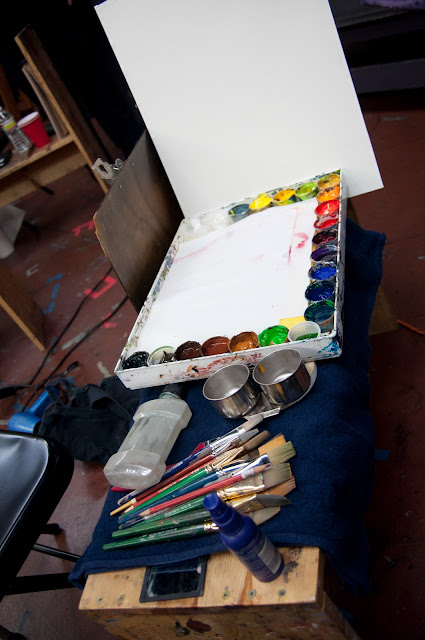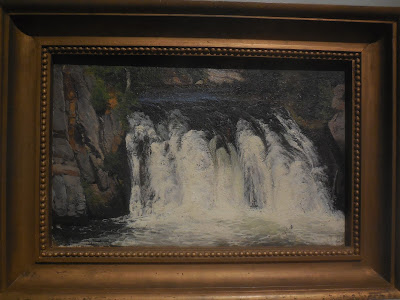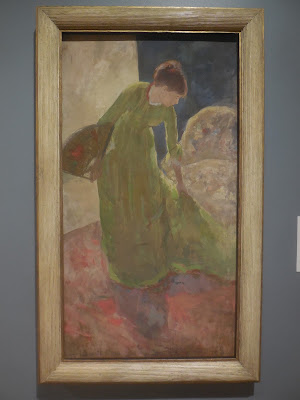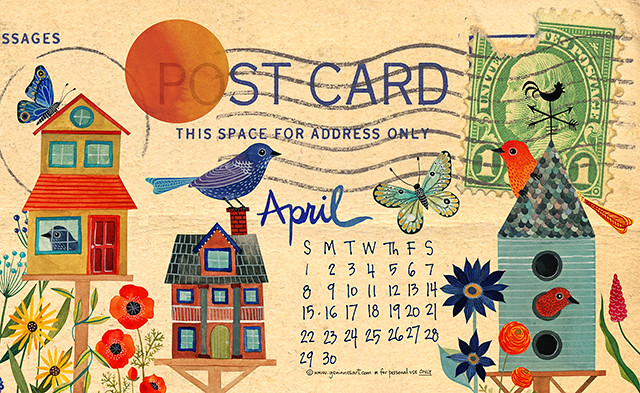Monday, April 30, 2018
A quilt show that I'd like to see
Catching up on my digital reading for the week, I finally got to read a review from Hyperallergic about a show of quilts at the Baltimore Museum of Art. They're made by Stephen Towns, a black artist who turned from his customary painting practice to make a series of ten quilts depicting scenes from the slavery era. In particular, most of the quilts focus on Nat Turner, who led an unsuccessful slave rebellion in 1831.
Stephen Towns, Birth of a Nation
I was impressed that the review avoided almost all of the cliches that sadly show up in so many critical discussions of quilts as art. The reviewer did not make a big deal out of Towns being a man in the predominantly female world of quilting. There was no mention of these quilts not looking like grandma's quilts. There was no flogging of the fake history that quilts were used to mark the route of the Underground Railroad.
I was also impressed that Towns apparently made the quilts himself by hand -- the review talks about his bleeding fingers -- instead of farming the work out to his mom. I liked the fact that he ransacked his parents' home for scraps from clothing made by his mother and sisters. Most of all, I was impressed that these quilts were hung in a mainstream art museum.
If you're in the vicinity of Baltimore, you might want to check it out; the show will be up through September 2. And I can testify that the rest of that museum is pretty wonderful too.
Sunday, April 29, 2018
Thursday, April 26, 2018
Spell check strikes again
I've never been a big fan of spell check because spell check can't think. As long as a word is in the dictionary it's OK with spell check, even if it's the rung worm. People neglect to proofread their own work because after all, they ran spell check! And I particularly hate spell check with autocorrect because -- well, you know why.
But when I was getting ready to send a new book off to Blurb for printing, I allowed the spell check to run just in case.
This is a spell check that suggests alternatives for the words it doesn't like. It didn't like "artwithaneedle," which was understandable. But I was surprised to see what it suggested instead:
(In case you can't read it, spell check suggested that I change it to "trichloroethane.")
Tuesday, April 24, 2018
Daily art report 5 -- maps of the USA
Recently I started a challenge to myself in my daily map project, having to do with the map of the United States. What is more familiar to us than that map -- we see it every day in the weather report, not to mention on schoolroom walls, in textbooks, in road atlases, and who knows where else. But I bet few of us know it so well that we can draw it without a cheat sheet.
I decided a map of the lower 48 would fit nicely on the page of my sketchbook, so I set out to draw it. I have been working quite a bit with copying maps from books, and enjoy trying to make good replicas by eye. I decided it would be a good challenge even if I had a map to copy from, so I tore out the weather map, which had the outlines of the states, and set to drawing.
And I should mention that I draw in ink, a deliberate choice of medium that encourages you to get it right the first time. (I love the ink lines; pencil seems too tentative, too faint.)
The outer perimeter of the map turned out pretty accurate, especially the Great Lakes. But when I started filling in the states I ran into difficulties. I would start from one corner and start to draw states, and maybe start again from another corner, but when it was time to meet in the center things didn't work out all that well.
Arizona and New Mexico ended up twice their real size, while Montana was half its real size. Texas ended up with an interesting northern edge, Tennessee was just downright strange and you can't find Delaware at all.
So I decided to do it again the next day.
This time things turned out better; I was careful to get Arkansas where it belongs. New York, West Virginia and the Dakotas flunked the shape test, but Maryland and Delaware were a whole lot better.
I was so excited with this exercise that I wanted to do it every day. Only problem: it took me two hours to draw the map and color it in. That's more time than I'm willing to devote to daily art, so I'll have to wait for days when I'm sitting around a table all afternoon talking and drawing.
If I do the map often enough, maybe I can achieve two goals by the end of the year: to be able to draw a stunningly accurate map while consulting a real map, all the states having their proper shapes and sizes; and to be able to draw an accurate map without consulting a real map. I think those are two separate skills and it would be nice to get them both.
The next week I decided to draw the outline of the United States while consulting my cheat sheet, but try to fill in the states from memory. This was such a spectacular failure that I drew over it again and again, trying to get a bit closer. Still need a bit of work on those skills.
Sunday, April 22, 2018
Friday, April 20, 2018
Women / Impressionism 6
One last post from the exhibit at the Speed Museum.
Whenever my friend Marti and I go to a museum we play a game at the end: which piece do you want to take home with you? It requires us to take one last walkabout, reminding ourselves of everything we've seen, and to discuss why this one is our favorite. (It's an exercise that I recommend to any serious art viewer, making sure that you haven't just looked without seeing and thinking.)
Here's Marti's favorite, which we both thought screamed "Vermeer" for its gorgeous light coming in from the side window.
Anna Ancher, Young Woman Arranging Flowers, ~1885
It struck me that hardly any of the paintings showed those classic Impressionist subjects of landscape or still life. Those have always been my favorite Inpressionist genres, and I had a hard time choosing my favorite from the few possibilities.
Fanny Churberg, Waterfall, 1877
This artist got no respect from the Finnish art world: they called her paintings "strange" and "abnormalities." Unsurprisingly, she gave up painting.
Marie Cazin, Evening, 1884-88
The dramatic smoke plume made me think of all those paintings of trains, especially inside the huge open-air railroad stations.
Helene Schjerfbeck, The Door, 1884
Anna Bilinska-Bohdanowicz, Unter den Linden in Berlin, 1890
This was my favorite, reminiscent of all the Childe Hassam paintings of New York street scenes with flags flying. I loved the way the precise detail of the architecture dissolved into hazy radiance.
Well, maybe not my absolute favorite -- how about a tie between that one and this beautiful still life of pink satin shoes. Not only do I love the painting, I sure wish I had a pair of shoes just like it.
Eva Gonzalès, The Pink Slippers, 1879-80
And that's all, folks! You still have a couple of weeks to see the exhibit, "Women Artists in the Age of Impressionism," which closes May 13. As the Michelin Guide says, it's worth a detour. Maybe even worth a trip.
Wednesday, April 18, 2018
Women / Impressionism 5
Almost done with my report on the "Women Artists in the Age of Impressionism" show at the Speed Museum in Louisville. Most of the work in the show was portraiture, and there were several that called out to me.
Cecilia Beaux, Sita and Sarita (Woman with a Cat), 1893-94
You come upon this painting from a far distance, and I didn't even see the cat until I got a whole lot closer. But how much the portrait sings when you do detect the cat among the shadows of her dark hair.
Amélie Beaury-Saurel, Into the Blue, 1894
Scholars think this is probably a self-portrait, which makes two strikes against Amélie -- a smoking artist!!!! Scandalous!!!!!!
And finally, this exciting picture of a young girl, which was chosen for one of the poster images to advertise the show.
Ellen Thesleff, Echo, 1891
Let's all imagine what she's shouting, what powerful words are echoing back to her. I hope it's something more important than just calling the cows home.
Monday, April 16, 2018
Women / Impressionism 4
A couple more posts about the exhibit at the Speed Museum about women painters in Paris during the late 19th century.
First off, a mea culpa -- I said incorrectly in earlier posts that the exhibit would close last week. Good news -- it's actually open through May 13, so if you're anywhere in the vicinity of Louisville, you still have time to drop by and enjoy this engaging show.
I'd like to show you my favorite pictures from the exhibit. Today, three paintings of mothers and children that hung right next to one another, which made me realize how all three of the mothers have the identical expression:
Cecilia Beaux, The Last Days of Childhood, 1883-5
(makes you wonder if childhood has been redefined in the last 135 years... I would think it lasted a whole lot longer....)
Paula Modersohn-Becker, Nursing Mother in Front of Birch Forest, 1905
Elizabeth Nourse, A Mother, 1888
Sunday, April 15, 2018
Saturday, April 14, 2018
Thursday, April 12, 2018
Crabby three times from the same story
Yesterday I was crabby about a woman who looked really old to me being described by the police as "55 to 60 years old." I submitted photos of women who are actually 55 to 60 years old, arguing that you can be that age and still look pretty damn good.
One of my readers took exception to my post, saying "I was not in the least offended by her being categorized as 55 to 60. I WAS rather offended at you trotting out photos of 55-60 year old movie stars and celebrities as the benchmark for what that age range looks like. Not my reality."
You're right, I should not have suggested that movie stars and celebrities should be held up as role models or reality benchmarks. So I have gone back and amended my post. No more celebrities. Instead, U.S. Senators and governors. You may want to go back and see how good they look.
And Idaho, thanks for keeping me honest.
Wednesday, April 11, 2018
Crabby twice from the same story
Yesterday I wrote about a "crime" that made me crabby -- a woman took a rock from a Yoko Ono exhibit that consisted of many, many rocks on the floor. And another thing about it made me crabby.
Here's the perp, surveillance photo courtesy of the Toronto police:
She is described as 55 to 60 years old.
Does this look like a 55-year-old woman to you? Looks more like 75 to me, or maybe 80 or 85.
Here's what some women 55 to 60 look like:
age 57
age 58
age 56
age 59
(Well, my friends in that age group don't look exactly like that, but that may be an issue of wardrobe.)
Because I am a late-middle-aged woman myself, I am particularly alert to what I see as the way society dismisses and devalues older women. Apparently in the eyes of the Toronto police, if you look old and doddery you must be (horrors) in your late 50s! I realize that if I were to be creamed by a runaway bus I would be described in the news report as "elderly," even though I think of myself as anything but.
What's up with this stereotyping? Don't any of the cops who put together this APB know a real 55- to 60-year-old woman? Or a real 80-year-old woman? Or don't they even look at women past a certain age, even if it's their own wife or mom?
Tuesday, April 10, 2018
Crabby about art
Every morning I get an email from Hyperallergic, a newsletter that covers the art scene (I recommend it to anybody who's interested in the wider world of mainstream art). Today's included a story about a woman who stole a rock from a Yoko Ono exhibit at a museum in Toronto.
The exhibit consisted of a whole lot of river stones that were apparently arranged artfully on the floor. Some of the stones were inscribed with messages such as "love yourself", written by Yoko herself. The shtick of the exhibit, which the museum describes as "collaborative," is that viewers are supposed to pick up a stone while "concentrating on the word and letting go of their anger or fear."
Then, presumably after the anger and fear are gone, they're supposed to put the stone back with the others. But a woman picked one up and failed to put it back. It's all on surveillance footage, and Toronto police are looking for the perp.
But I have mixed feelings about this story.
First off, you know I have a jaundiced view of these "collaborative" or "relational" art projects, having devoted too much of my own time to participating in one a couple of years ago. The plan is to make people feel all warm and fuzzy by picking up the rock and thinking about loving themselves, or helping to mend a broken teacup (another part of the Ono show in Toronto). According to Hyperallergic, this approach is "encouraging viewers to engage intimately with artworks."
Sometimes, I guess, such exhibits can make you think deeply or feel great emotion, but mostly I find them manipulative and cynical. Geez, "love yourself" is kinda shallow, not to mention unoriginal, don't you think?
Second, if a show is all about encouraging people to engage intimately with the art, isn't it a bit hypocritical to call the cops if they engage a little bit too intimately? What if in all sincerity this woman picked up the stone, tried hard to love herself, concentrated on it, concentrated on it, concentrated some more, but could never quite let go of her anger or fear? And since it was almost closing time, thought she could take it home and keep concentrating?
But third, here's what really got me crabby about this story: the stone was described with a straight face as "valued at $17,500." Hmmm. Are they selling individual rocks in the gift shop for $17,500? That would make that whole big pile on the floor (who knows how far it extends beyond the photo) worth -- what? -- millions? In the next room was a setup where viewers were invited to use hammers and nails to stretch pieces of string to make "lines in space." I wonder what a piece of string or a nail would be "valued at" if some viewer, in the spirit of collaboration and intimate engagement with art, decided to take one home?
I don't recommend that museums allow people to take home the art -- although there have been lots of "relational" projects in museums that do exactly that -- but for heaven's sake, if somebody takes home a rock, and you think it leaves a terrible gap in the pile on the floor, go get another rock. It won't cost you anywhere near $17,500.
This sort of pretentiousness is what gives art a bad name among ordinary people. What do you think?
Monday, April 9, 2018
Women / Impressionism 3
Everybody knows Mary Cassatt as the painter of adorable babies, but that was not her only skill. The exhibit "Women Artists in the Age of Impressionism" includes lots of her work.
Yes, there were adorable babies. You probably know the first one, but maybe not the second:
Children Playing on the Beach, 1884
Spring: Margot Standing in a Garden, 1900
Can you imagine putting that hat on a little girl to go out and play? Obviously Margot wasn't encouraged to climb trees or turn somersaults.
Here are some adults:
The Reader, 1877
Although Cassatt's signature style is highly realistic, I was intrigued by two paintings that were much more gauzy.
Woman Standing, Holding a Fan, 1878-9
The focus here is on the dress rather than its wearer; in particular the foofy lace on the left sleeve is almost luminous with back lighting. I'd much rather have this painting in my living room than the one of the reader.
Autumn, Portrait of Lydia Cassatt, 1880
This portrait of the artist's sister is like two arts in one -- the face realistic, the patterned blanket almost abstract. In fact, the loose brushwork of the blanket reminded me of Gerhard Richter's squeegee paintings!
Gerhard Richter, Abstraktes Bild, 1991
This is the last week of the show at the Speed Museum in Louisville.
Sunday, April 8, 2018
"Demo at Ponte Vedra Beach 2018 2" --- Sold
I love to paint buildings, you know that. This is a black smith's shop in Louisiana. I took a photo, and did this painting reference to the photo. I feel the color scheme for this painting maybe too cool.
Thursday, April 5, 2018
Women / Impressionism 2
The curators' statements on the walls of the Speed Museum's exhibit "Women Artists in the Age of Impressionism" contained some language that I didn't love, to the effect that women of course had a special facility for painting domestic scenes. Because of course men don't have breakfast tables or children, right? Can you deduce the gender of the artist in comparing these two classic Impressionist scenes:
Well, be that as it may, there were some nice domestic scenes portrayed in the show.
Harriet Backer, Big Brother Playing, 1890
Berthe Morisot, The Artist's Daughter, Julie, with her Nanny, 1884
Probably my favorite was this:
Marie Bracquemond, Under the Lamp, 1887
Probably the artist didn't intend it this way -- or did she? -- but to my eye the husband is a disembodied presence floating on the mist of the hot soup, ignored by the woman staring off into the wings. Maybe he's just a disapproving spirit who hovers over her life and makes her feel under surveillance even if he's not there. Or maybe he's really there, and she's just wondering how come he gets to drink all the wine.
Oh, and the top picture of women in a boat was by Claude Monet, the bottom picture was by Berthe Morisot. Did you guess right?
Wednesday, April 4, 2018
"Still Life Workshop at Austin"
I would like to announce my painting workshops in Austin for 2018. I will teach a 4-day still life workshop on June 20 - 23, and a landscape workshop on November 10 - 12. I have just created a webpage for the June Still Life Workshop. Please check the info and sign up.
Women / Impressionism 1
A fascinating exhibit at the Speed Art Museum in Louisville focuses on women artists who came to Paris during the second half of the 19th Century even though the deck was seriously stacked against them. They couldn't attend the big art schools, had a hard time showing their work through the official Salon, couldn't draw nude models, couldn't go to certain public places without chaperones, were advised by their teachers to abandon art when they got married. Nevertheless they came, and they learned to paint, and they made lovely paintings.
I was impressed by how many of them had success despite these obstacles. Many had work eventually accepted to the Salon, a few were given honors such as the Legion of Honor. Of course the praise was grudging -- lots of critics' remarks quoted on the wall signs to the effect of "it's astounding that a woman painted this!!"
Marie Bashkirtseff, In the Studio, 1881
The Académie Julian was one of a few small art schools that admitted women. Originally it allowed male and female students to work in the same room from a nude model (gasp!) but after too many gasps had to have separate studios for men and women. Here's the women's studio; Marie, who was from Ukraine, is center front with black dress and big palette.
I was unfamiliar with most of the artists in the Speed show; many of them returned to their native countries after studying in Paris and did not have a chance to make names for themselves internationally even if they were well-regarded at home. I had heard of only four: Berthe Morisot, Mary Cassatt, Rosa Bonheur and Paula Modersohn-Becker.
More tomorrow, with lots of pictures. Meanwhile, click on the link at the top of this post and you can watch a slide show of many of the paintings from the show, which is up through May 13.
Tuesday, April 3, 2018
"Demo at Ponte Vedra Beach 2018 1" -- Sold
This is another palm tree demo. I did this at Ponte Vedra Beach Florida.
Thanks to so many friends responded to my last post. I understand there are issues we should not openly talk about, but have we noticed those issues are all important issues. Well, let paint more palm trees. because all those trees are supporting each other and forms a beautiful scene, and it helps us to make a beautiful painting.
Subscribe to:
Comments (Atom)


















































